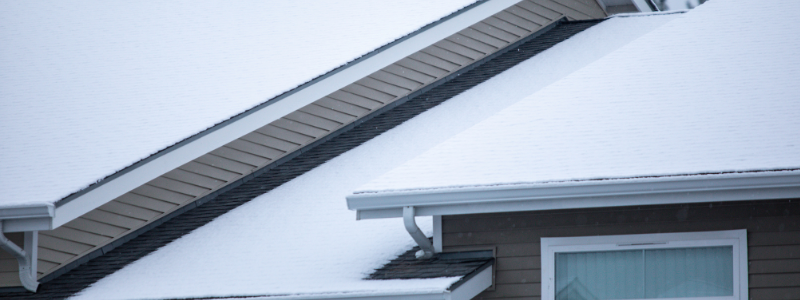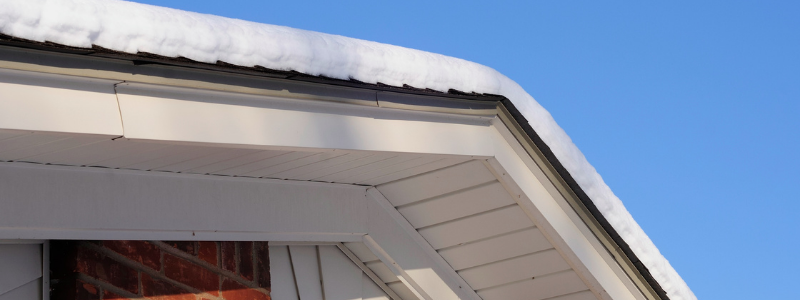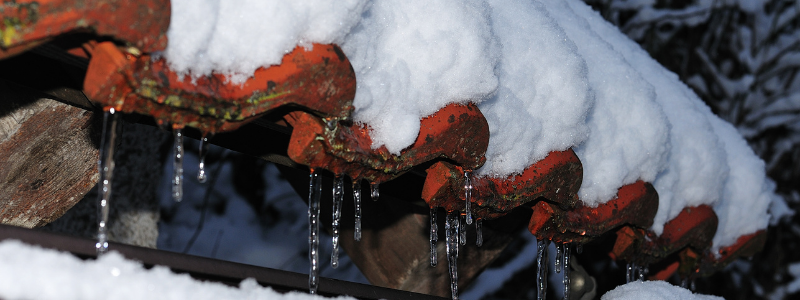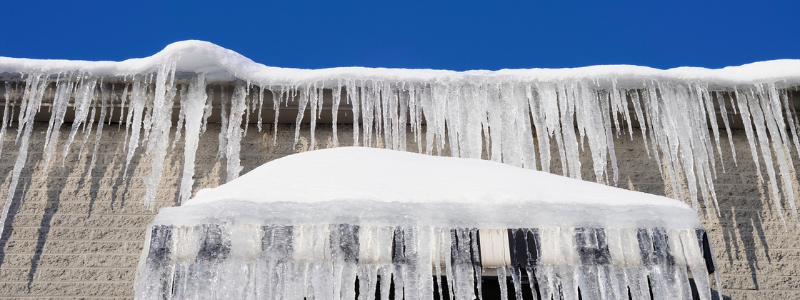
Snow Damage to Roofs
We’re no strangers to snow here in Colorado. Unlike most other places, we can get a thick blanket of the cold stuff every month of the year — not that we let it get in our way! However, when the winter months roll around, the snow can get particularly problematic, especially for our roofs.
As beautiful as a vista of wintery whiteness can be when we look out our windows in the morning, Jack Frost can damage our roofs in a number of ways. Snow damage to roofs is no joke, so it’s better to know what can happen to either prevent it from happening or know how to deal with it during the cold months.

Snow Damage to Roofs: Full On Collapse
A single snowflake may not weigh all that much (roughly 0.02 g), but when thousands of these little fluffy hexagons get together, they can be extremely burdensome for the surface beneath.
According to Accuweather’s in-house forensic meteorologist, the typical roof of a house in a northeastern State can support around 30lbs per square foot, while others in snowier states such as Colorado may be able to handle between 40 and 100 lbs per square foot.
This means that, depending on your location, anything upward of 4 ft of fresh snow or 2 ft of compacted snow can be a real threat, and roofs that haven’t been repaired or inspected in a while are at an even higher risk of collapse.
If you have any external roof units such as parapets or air conditioners, they can cause an excess drift in certain areas amounting to uneven weight distribution and, again, an increased risk of sagging or collapse.
Don’t worry if you’re not sure how much snow your roof is rated to hold, as you can check out our in-depth Colorado Snow Load Guide that takes you through a step-by-step snow load calculation process.
The Fix
The snow needs to be removed, otherwise, it will compact over time, and, eventually, rainfall will add to the weight, increasing the strain on your roof. You may want to invest in a scraping tool such as a roof rake to remove snow, but this should only be used if the roof is low and there is minimal risk of injury.
It’s also important to bear in mind that the scraping tool itself will add weight to the rooftop, and, in some instances, may end up being the straw that broke the camel’s back, which is why we’d recommend contacting our experienced team before attempting a DIY fix.
Preventative Measures
The best thing you can do to prevent a snow-based roof collapse is to contact your local roofing contractor before winter strikes. They will do a thorough inspection of your roof, and advise on any repairs or reinforcements that will help your roof shoulder the weight of the coming snow.
If you’re planning on having a roof installed in the coming months, It’s critical to understand what type of roof is best for snow, before construction commences. That way, you’ll put yourself in the best possible position if you’re hit by unusually extreme weather conditions come winter.

Snow Damage to Roofs: Snowmelt and Ice Dams
You’d be forgiven for thinking that if the snow on your roof starts to melt, your problems are a thing of the past, but sadly, they’re only just beginning.
As the snowy season is so cold, it stands to reason that you’ll be heating your house, either with fires or central heating. Well, the hot air that keeps your fingers, toes, and unmentionables from freezing, rises, eventually hitting the underside of your roof shingles.
Warming up over time, the central shingles melt the snow above, causing meltwater to run off towards the colder edges of your roof where it refreezes. The ice builds up at these peripheral points, amassing more and more meltwater.
What does this mean? Well, as snow and ice thaws and refreezes, it expands, prying open leakage points that can cause floods upon the next melt.
The Fix
There are a couple of things you can do to prevent further damage if you’ve already been struck by leaking caused by ice dams, including setting up a box fan in your attic aimed at the leak point to freeze the water as it enters the property.
Another neat trick is to fill some pantyhose with calcium chloride ice melter and lay them across the dam; however, you should only try this if it’s safe to do so.
Preventative Measures
The best way to ensure you never have to face damage from ice dams is to hire a contractor to make sure your attic is properly insulated and ventilated. We’d also recommend having an ice and water shield installed below your shingles.
Something you can do yourself to keep ice dams at bay is clearing your downspouts and gutters towards the tail-end of fall, so meltwater can flow freely from your roof.
Snow Damage to Roofs: Icicle Formation
If your roof suffers from ice dams, then there’s a good chance you’ll notice the formation of icicles around its perimeter, and while these look quite pretty, they can be a big problem!
They can weigh down and break your gutters, damage your shingles, and possibly even snap, fall, and hurt unfortunate people or pets below.
The Fix
As long as it’s safe to do so, you can gently knock icicles loose using a broom or rake handle. If you’re climbing a ladder to reach them, make sure it’s secure, and recruit a friend or family member to hold it in place.
Preventative Measures
Much like ice dams, you can combat icicle formation by ironing out the kinks in your attic’s insulation and eliminating rooftop air seepage. Installing ice-melting roof cables is also an option.

Snow Damage to Roofs: Attic Condensation
Winter build-ups on your roof can also cause excessive condensation in your attic ceiling, especially if ice dams are already established. This may not sound that serious, comparatively speaking, but it can actually be incredibly damaging.
The excess moisture will saturate the wood, causing mold and wood rot, compromising the structural integrity of your roof from the inside. Then it’s at a greater risk of sagging and collapse due to diminished weight-bearing capabilities.
What’s more, the damp is liable to spread to attic furnishings and stored items, so it’s a good idea to clear the space if you notice any dark, moist areas in your attic ceiling.
The Fix
Your first port of call should be to remove or deactivate any appliances or plumbing that may be malfunctioning and worsening the moisture build-up. Once they’re out of the way, seek out and plug any leak zones in your attic floor insulation.
Preventative Measures
Once again, optimizing your attic insulation and ventilation is absolutely key in preventing the build-up of excess condensation.
How Much Snow Damage Is Too Much to Repair?
In an ideal situation, professionals such as ourselves will be able to repair and reinforce your existing roof, but if the damage is too severe, the only option is to replace the whole structure.
If, for example, you’re experiencing leaks at a number of points across the entire roof, repairs will only be a fleeting fix, as the issue is so widespread that it’s bound to flare up again.
A general rule of thumb most roofers live by is that repairs will be effective if they cover 30% or less of the damned roof. Anything beyond that is like placing a band-aid on a bullet wound.
How B&M Roofing Can Help with Snow Damage
We know that all this information can be quite jarring, and while it should be taken seriously, we want you to know that you’re not alone in dealing with your winter roof woes.
No matter which of these winter roof problems you’re worried about or are currently dealing with, B&M Roofing can help! Our team of seasoned experts has the skills to ease the burden the snow is placing on both you and your roof, so you can enjoy the holiday season knowing the roof over your head is safe and secure. We specialize in both commercial roofing and residential roofing, so if your property is situated in or around the Denver area, please don’t hesitate to contact us for some support in winterizing your roof.




































